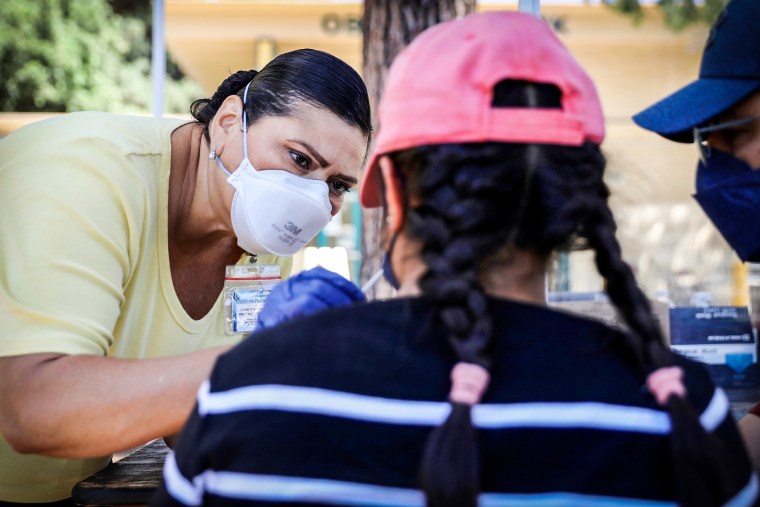Covid, flu and respiratory syncytial virus (RSV) are together driving a national wave of respiratory illnesses.
Around 79% of U.S. hospital inpatient beds are full, according to data from the Department of Health and Human Services. Pediatric beds are at 74% occupancy, though seven states and Washington, D.C. have more than 90% of their pediatric beds full, according to an NBC News analysis of HHS data.
Covid, flu and RSV can be difficult to distinguish, since they share many common symptoms. But it's useful to know which virus you have, since that determines the treatments you should receive and how long you should isolate.
Certain hallmarks — either symptoms or how the illness progresses — can help differentiate each virus. Here are five factors to consider.
Some symptoms are unique to particular viruses
A runny nose, cough, congestion or sore throat can arise because of any of the three viruses or a common cold. But a loss of taste and smell is more commonly associated with Covid than with flu or RSV. And wheezing is often a tell-tale sign of a serious RSV infection, usually found in kids or older adults.
The only way to know for certain, though, is to get tested.
"I don’t think anybody would ever go, 'Hey, listen, I think you have a virus based on your symptoms,' and feel confident to say what virus that is," said Dr. Frank Esper, a pediatric infectious disease specialist at Cleveland Clinic.
Are symptoms coming on gradually or all of a sudden?
Flu symptoms tend to develop more suddenly than those of Covid or RSV.
"Flu classically comes on with an abrupt fever first that happens pretty quickly. That’s somewhat contrasted by RSV and Covid, where we think of a slow escalation in symptoms," said Dr. Scott Roberts, a Yale Medicine infectious disease specialist.
How long has it been since exposure?
The illnesses have different incubation periods — the time between exposure and symptoms. On average, flu symptoms tend to develop two days after exposure to the virus, whereas RSV symptoms tend to take around four to six days to appear, and Covid's typical incubation is three to four days for the omicron variant.
"If I go to a party and I get symptoms the next day, it’s probably flu because that can be as short as 24 hours’ incubation period," Roberts said.
Age makes a big difference in a disease's symptoms and severity
RSV is unlikely to make a healthy adult feel very sick, whereas Covid and flu certainly can.
"In general, if you’re a young healthy adult or you’re not in an extreme of age, and you get pretty severe illness, it’s probably not RSV," Roberts said.
The groups most vulnerable to severe RSV infections are babies, children with lung diseases, adults ages 65 and up and people with weakened immune systems.
Symptoms can also look different depending on your age and immune status. Many kids are encountering respiratory viruses for the first time this year as they return to regular schooling and socializing, so their bodies may have a harder time clearing the infection, which can lead to more wide-ranging symptoms.
According to Esper, almost a fourth of children have gastrointestinal symptoms — like diarrhea, stomach pain or vomiting — from viral infections. That's less common in adults with seasonal flu or RSV.
People with weakened immune systems, meanwhile, are more likely to develop severe symptoms or pneumonia from any of the three viruses.
Consider which virus is circulating the most in your community
Nationally, RSV infections appear to have passed their peak. Although the Centers for Disease Control and Prevention does not keep precise count of RSV cases in the U.S., its data shows the number of positive weekly tests fell 75% in the last month, from nearly 20,000 in the week ending Nov. 12 to less than 5,000 last week.
Roberts said the number of RSV cases at his hospital have halved since their peak in late October.
Meanwhile, Covid cases are climbing as people travel and gather indoors for the holidays. Average daily cases reported to the CDC have risen nearly 45% over the last two weeks, according to NBC News’ tally.
It's difficult to determine local Covid transmission levels, since many people use at-home tests. (RSV and flu tests, by contrast, are performed at a doctor’s office or ordered via prescription.) But Roberts said the Covid situation is “nowhere near the holiday omicron surge we saw last year,” though cases are “going in the wrong direction.”
Flu cases may be reaching their peak. The national share of influenza tests coming back positive has hovered around 25% for at least two weeks. Flu hospitalizations are still the highest they've been at this time of year in more than a decade.
The Cleveland Clinic said 30% of its flu tests are coming back positive, compared with 10% of its Covid tests and 5% of its RSV tests.
Available treatments and vaccines
Unlike Covid and the flu, there are no vaccines or universally prescribed treatments for RSV.
Doctors can prescribe Paxlovid for some people with Covid, and there are four approved treatments to reduce the length of flu symptoms, including the go-to drug, Tamiflu.
Roberts said he is most concerned about flu at the moment because of high case numbers, coupled with Tamiflu shortages at pharmacies in some parts of the country.
"I worry about the vulnerable groups — the very young and the very old and those with low immune systems — and their access to Tamiflu if they do get diagnosed,” he said. "That's my biggest concern right now."

